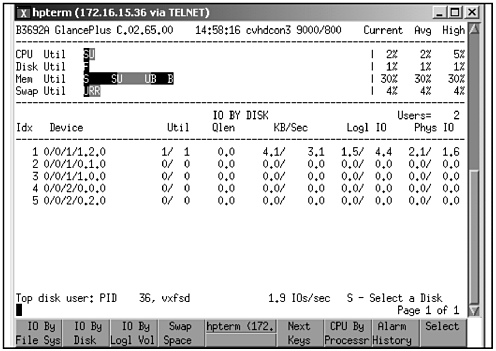HP GlancePlus/UX Working with Glance in vPars is identical to working with Glance on a nonvPars system, except with vPars you will see in Glance only the components that are assigned to the vPar you are analyzing. This means that if you're running two vPars on a system, you would run Glance in whatever vPar in which you want to perform analysis. Figure 12-1 shows a Glance screen shot of vPar cable1, which has a hostname of cvhdcon3: Figure 12-1. HP GlancePlus/UX Showing Two CPUs of vPar  Figure 12-1 shows that there are two CPUs present in this vPar. The system on which this vPar is running is a four-processor L-Class system. The vPar was configured with only two CPUs, so even though this is a four-processor system only two are shown in the Glance screen shot of this vPar. Where are the other processors you ask? It may be that the vPar(s) in which the other processors are configured are not even running, so the CPUs my be unused at this time. It may be that the other vPar(s) are up-and-running and one or two additional CPUs, depending on how the additional vPar(s) are configured, are in use. If the other vPar(s) are running, invoking Glance in those vPars would show the additional CPU(s) in use. The other components of which your vPar is comprised will also be shown in Glance. Figure 12-2 shows the disks of vPar cable1: Figure 12-2. HP GlancePlus/UX Showing Two CPUs of vPar  This is the same list of disks as we saw for cable1 in the ioscan -funC disk output. Only the first disk shown in Figure 12-2 has been included in the vPar for which the Glance screen shot was produced. The other devices shown are also connected to the SCSI channels that are part of the Core I/O card that was included when the vPar was created with -a io:0/0. The boot disk was explicitly included when the vPar was created with -a io:0.0.1.1.2.0:BOOT, so you would expect it to be shown in Glance. The other devices are part of the vPar also because they are part LBA at 0/0. There are other implied components of this vPar as well, including the LAN interface at 0/0/0/0 and the console at 0/0/4/0. For more information on how vPars were created please see Chapter 2 as well as the tear-out card included in this book. The remainder of this chapter includes background information on commands and tools used for performance analysis. |